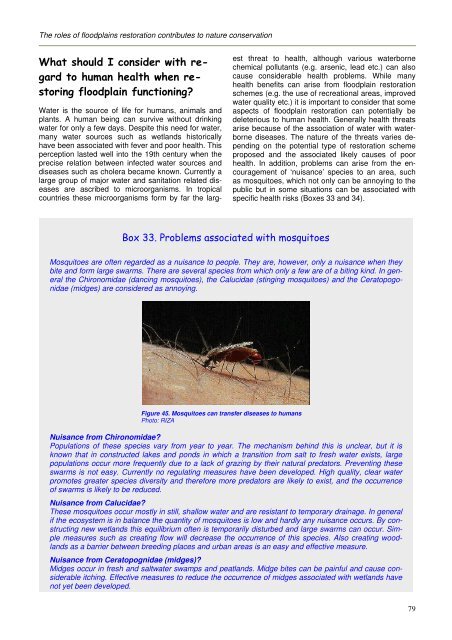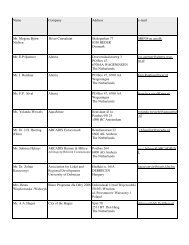HOW TO USE FLOODPLAINS FOR FLOOD RISK ... - SGGW
HOW TO USE FLOODPLAINS FOR FLOOD RISK ... - SGGW
HOW TO USE FLOODPLAINS FOR FLOOD RISK ... - SGGW
You also want an ePaper? Increase the reach of your titles
YUMPU automatically turns print PDFs into web optimized ePapers that Google loves.
The roles of floodplains restoration contributes to nature conservation<br />
, 2<br />
/ , 2<br />
-<br />
Water is the source of life for humans, animals and<br />
plants. A human being can survive without drinking<br />
water for only a few days. Despite this need for water,<br />
many water sources such as wetlands historically<br />
have been associated with fever and poor health. This<br />
perception lasted well into the 19th century when the<br />
precise relation between infected water sources and<br />
diseases such as cholera became known. Currently a<br />
large group of major water and sanitation related diseases<br />
are ascribed to microorganisms. In tropical<br />
countries these microorganisms form by far the larg-<br />
!! . ( 7 " ( <<br />
est threat to health, although various waterborne<br />
chemical pollutants (e.g. arsenic, lead etc.) can also<br />
cause considerable health problems. While many<br />
health benefits can arise from floodplain restoration<br />
schemes (e.g. the use of recreational areas, improved<br />
water quality etc.) it is important to consider that some<br />
aspects of floodplain restoration can potentially be<br />
deleterious to human health. Generally health threats<br />
arise because of the association of water with waterborne<br />
diseases. The nature of the threats varies depending<br />
on the potential type of restoration scheme<br />
proposed and the associated likely causes of poor<br />
health. In addition, problems can arise from the encouragement<br />
of ‘nuisance’ species to an area, such<br />
as mosquitoes, which not only can be annoying to the<br />
public but in some situations can be associated with<br />
specific health risks (Boxes 33 and 34).<br />
Mosquitoes are often regarded as a nuisance to people. They are, however, only a nuisance when they<br />
bite and form large swarms. There are several species from which only a few are of a biting kind. In general<br />
the Chironomidae (dancing mosquitoes), the Calucidae (stinging mosquitoes) and the Ceratopogonidae<br />
(midges) are considered as annoying.<br />
Figure 45. Mosquitoes can transfer diseases to humans<br />
Photo: RIZA<br />
Nuisance from Chironomidae?<br />
Populations of these species vary from year to year. The mechanism behind this is unclear, but it is<br />
known that in constructed lakes and ponds in which a transition from salt to fresh water exists, large<br />
populations occur more frequently due to a lack of grazing by their natural predators. Preventing these<br />
swarms is not easy. Currently no regulating measures have been developed. High quality, clear water<br />
promotes greater species diversity and therefore more predators are likely to exist, and the occurrence<br />
of swarms is likely to be reduced.<br />
Nuisance from Calucidae?<br />
These mosquitoes occur mostly in still, shallow water and are resistant to temporary drainage. In general<br />
if the ecosystem is in balance the quantity of mosquitoes is low and hardly any nuisance occurs. By constructing<br />
new wetlands this equilibrium often is temporarily disturbed and large swarms can occur. Simple<br />
measures such as creating flow will decrease the occurrence of this species. Also creating woodlands<br />
as a barrier between breeding places and urban areas is an easy and effective measure.<br />
Nuisance from Ceratopognidae (midges)?<br />
Midges occur in fresh and saltwater swamps and peatlands. Midge bites can be painful and cause considerable<br />
itching. Effective measures to reduce the occurrence of midges associated with wetlands have<br />
not yet been developed.<br />
79




